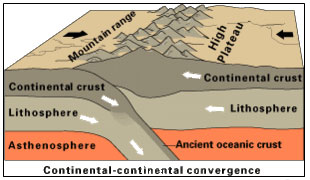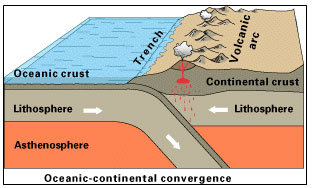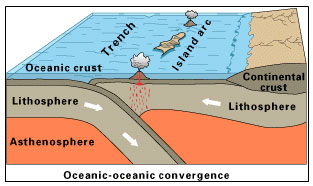A. Continental/Continental Collisions – When two tectonic plates with continental crust collide, they buckle and thicken and push the continental crust upward. This leads to the eventual formation of mountains.

All tectonic plates have boundaries with other tectonic plates. Tectonic plates can collide, separate, or slide past each other. How the plates move in relation to one another is used to classify the boundaries.
Convergent Boundaries
When two tectonic plates push into one another, the boundary where they meet is called a convergent boundary. What happens when two plates collide depends on the type of crust, continental or oceanic, the edge of the plate has. There are three types of convergent boundaries.
A. Continental/Continental Collisions – When two tectonic plates with continental crust collide, they buckle and thicken and push the continental crust upward. This leads to the eventual formation of mountains.

B. Continental/Oceanic Collisions – When a plate with a continental crust collides with a plate with an oceanic crust, the oceanic plate slides under the continental plate. The region where the oceanic plate sinks down into the asthenosphere is called a subduction zone. Most volcanic mountains form over the types of convergent boundaries that include a subduction zone.

C. Oceanic/Oceanic Collisions – When two plates with oceanic crust collide, one of the plates slides under the other and creates a subduction zone much like when continental and oceanic crust collide. Again, most volcanic mountains form over the types of convergent boundaries that include a subduction zone.

Divergent Boundaries
When two tectonic plates move away from one another, the boundary between them is called a divergent boundary. Divergent boundaries occur where plates are moving apart and new crust is created by magma pushing up from the mantle. The sea floor spreading that we discussed in section 4 of this lesson is an example of divergent boundaries and is the most common type of divergent boundary. However, divergent boundaries can also be formed on continents.
Transform Boundaries
When two tectonic plates slide past each other horizontally, the boundary between them is called a transform boundary. The San Andreas Fault, in southern California, is an example of a transform boundary. This fault was formed by the Pacific plate and the North American plate sliding past each other.

![]() The image below shows the location of the different types of boundaries. Click on the map to access the activity. Then, click the different plate boundaries (located in the Explanation box on the map) to see where they are located.
The image below shows the location of the different types of boundaries. Click on the map to access the activity. Then, click the different plate boundaries (located in the Explanation box on the map) to see where they are located.